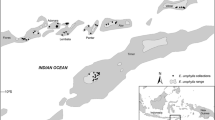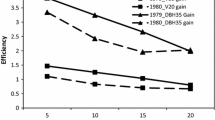Abstract
This paper reports early results from the provenance/progeny trials in Colombia, Costa Rica, Guatemala, Indonesia, Mexico and Venezuela. These were the first international collections of gmelina that were by mother tree and also the first ever to be made in Myanmar. Collections were made from 440 mother trees in 22 provenances (20 trees per provenance), while for eight provenances, bulk seed collections were made, typically from 20 trees. In this study, results from 31 tests planted in six countries are reported. At all ages, single-site heritability estimates for height, DBH, and volume were moderately low, around h 2b =0.10. The proportion of provenance variation ranged from p 2b =0.05-0.13, and averaged around 0.10. These levels are somewhat higher than has been observed for other forest tree species. Strong age-age additive genetic correlations were found for all growth traits and all age combinations. There was relatively little G × E at the provenance level (rBg = 0.73), and relatively substantial G × E at the family (i.e., additive genetic) level (rBg = 0.40). Three provenances from Thailand all were below average for 2-year/3-year volume (mean BLUP = −16.3%). These three sources were among the lowest latitude sources (below 15 °N) in the study. Indian provenances ranged widely in growth performance. Of the 10 provenances from Myanmar, only two were below average. There is sufficient genetic variability to make good gains in breeding. Gain in 2-year/3-year volume from provenance selection should be on the order of +10%, and expected gain from selection of the best genotypes within provenance (e.g., the top 5%) should be on the order of +25%.
Palabra Clave: Ganancia genética, Heredabilidad, Variación de procedencia
Resumen. Este artículo presenta los primeros resultados de los ensayos de procedencia/progenie en Colombia, Costa Rica, Guatemala, Indonesia, México y Venezuela. Estas fueron las primeras colectas internacionales de gmelina separada por árboles madre y también las primeras en Myanmar. En 22 procedencias, se colectaron 440 árboles madre (20 árboles por procedencia), mientras que en 8 procedencias se hicieron colectas a granel, típicamente de 20 árboles. En este estudio se presentan los resultados de los 31 ensayos plantados en seis países. En todas las edades, los estimados de heredabilidad de un solo sitio, para la altura, el DAP y el volumen, fueron moderadamente bajos, alrededor de h 2b =0.10. Estos niveles son un poco más altos que los que se han observado para otras especies de árboles forestales. Se encontraron correlaciones genéticas aditivas fuertes de edad-edad para todas las características de crecimiento y todas las combinaciones de edades. Se encontró relativamente poca interacción G × A (Genotipo × Ambiente) al nivel de procedencia (rBg = 0.73), y una G × A relativamente sustancial al nivel de familia (i.e., genética aditiva) (rBg = 0.40). Las tres procedencias de Tailandia, estuvieron por debajo del promedio para los 2-años/3-años en cuanto al volumen, (promedio BLUP = −16.3%). Estas tres fuentes provienen de las latitudes más bajas (por debajo de 15 °N). Las procedencias de la India tuvieron un crecimiento muy variado. De las 10 procedencias de Myanmar, solo dos clasificaron por debajo del promedio. Existe suficiente variabilidad genética para obtener buenas ganancias con el mejoramiento genético. Las ganancias en volumen al seleccionar por procedencia a los 2-años/3-años debe estar en el orden del +10%, y la ganancia esperada de los mejores genotipos dentro de una procedencia (por ejemplo, el mejor 5%) deben estar en el orden de +25%.
Similar content being viewed by others
References
Alfaro M.M. and De Camino R.V. 2002. Melina (Gmelina arborea) in Central America. Forest Plantations Working Paper 20. Forest Resources Development Service. Forest Resources Division. FAO, Rome, 18 p.
Bolstad P.V. and Bawa K.S. 1982. Self incompatibility in Gmelina arborea L. (Verbenaceae). Silvae Genet. 31: 19–21.
Bowen M.R. and Eusebio T.V. 1983. Gmelina arborea flowering and seed studies. Forest Genet. Res. Inform. 12: 27–28.
Cornelius J. and Hernández M. 1995. Variación genética en crecimiento y rectitude del fuste en Gmelina arborea en Costa Rica. Boletín mejoramiento genética y semillas forestales. CATIE, Turrialba, Costa Rica, (10): 9.
Dvorak W.S. 2003. World view of Gmelina arborea: opportunities and challenges. In: Dvorak W.S., Hodge G.R., Woodbridge W.C. and Romero J.L. (eds) Recent Advances with Gmelina arborea. CD-ROM. CAMCORE, North Carolina State University, Raleigh, North Carolina, USA.
Eldridge K. 1995. Eucalypt base populations for selection. In: IUFRO Proceedings Eucalypt Plantations: Improving Fibre Yield and Quality. Hobart, Tasmania, Australia, pp. 204–207.
Eldridge K., Davidson J., Harwood C. and van Wyk G. 1994. Eucalypt Domestication and Breeding. Clarendon Press, Oxford, UK, 288 p.
Hodge G.R. and Dvorak W.S. 1999. Genetic parameters and provenance variation of Pinus tecunumanii in 78 international trials. Forest Genet. 6(3): 157–180.
Hodge G.R. and Dvorak W.S. 2001. Genetic parameters and provenance variation of Pinus caribaea var. hondurensis in 48 international trials. Can. J. Forest Res. 31: 496–511.
Hodge G.R., Pepe B., Wijoyo F.S. and Dvorak W.S. 2001. Early results of Eucalyptus urophylla provenance progeny trials in Colombia and Venezuela. In: Developing the Eucalypt of the Future, Proceedings, IUFRO Working Party 2.08.03, Valdivia, Chile, Sept 9–13.
Lauridsen E.B. 2003. Features of some provenances in an international provenance experiment of Gmelina arborea. In: Dvorak W.S., Hodge G.R., Woodbridge W.C. and Romero J.L. (eds) Recent Advances with Gmelina arborea. CD-ROM. CAMCORE, North Carolina State University, Raleigh, North Carolina, USA.
Lauridsen E.B. and Kjaer E.D. 2002. Provenance research in Gmelina arborea Linn., Roxb. A summary of results from three decades of research and a discussion of how to use them. Int. Forestry Rev. 4(1): 1–15.
Lauridsen E.B., Kjaer E.D. and Nissen M. 1995. Second Evaluation of an International Series of Gmelina Provenance Trials. DANIDA Forest Seed Centre, Humlebaek, Denmark, 120 p.
Leaky R.R.B. 1987. Clonal forestry in the tropics: developments, strategies, and opportunities. Commonwealth Forestry Rev. 66(1): 61–75.
Lega F.F. 1988. Estudio de la forma de Gmelina arborea (Roxb). Análisis de las plantaciones de Manila, Siquirres. M. S. Thesis, CATIE, Turrialba, Costa Rica, 146 p.
Lokmal N. 1994. Genetic parameters of Gmelina arborea: height and diameter growth. J. Tropical Forest Sci. 7(2): 323–331.
Wijoyo F.S. 2000. A study of genetic parameters of Gmelina arborea Roxb. from Thailand grown in 5 countries. M. S. Thesis, College of Natural Resources, North Carolina State University, Raleigh, North Carolina, USA, 101 p.166
Author information
Authors and Affiliations
Rights and permissions
About this article
Cite this article
Hodge, G., Dvorak, W. The CAMCORE international provenance/progeny trials of Gmelina arborea: genetic parameters and potential gain. New Forests 28, 147–166 (2004). https://doi.org/10.1023/B:NEFO.0000040942.34566.a7
Issue Date:
DOI: https://doi.org/10.1023/B:NEFO.0000040942.34566.a7




